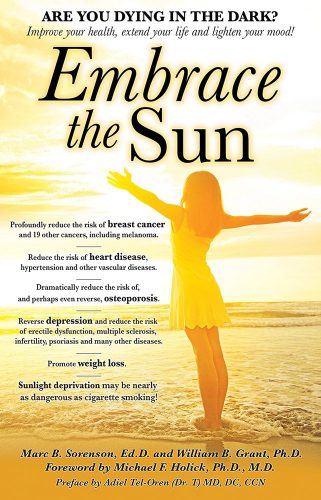Childhood diseases prevented by Sunlight. by Marc Sorenson, EdD
Childhood diseases are directly associated with sun deprivation: Therefore, childhood death and disability can be due to lack of sun exposure!

Childhood diseases and disorders that are prevented by sun exposure have been discussed on many of my recent blogs. Our children are becoming ill due to our neglect. We must insist that they (or in some cases their mothers) play outside each day while eschewing their electronic devices. So, let’s now discuss a few more childhood diseases that are associate with sun deprivation. First of all, there is a 61% increase in death risk among children born to women with low 25(OH) D levels. Since sun exposure on skin is the main source of that photoproduct (vitamin D), the mothers lack sufficient sun exposure. Therefore, they do not furnish the necessary vitamin D to deliver a healthy baby. Furthermore, they are unlikely to bring their babies out in the sun after birth.
It is probably important at this point to mention a vital point. In many cases, vitamin D is exceptionally important. And in other cases, vitamin D may have little to do with the childhood diseases being considered. Since sun exposure leads to vitamin D production, vitamin D levels may simply be a surrogate measurement for sun exposure. Therefore, it may be other photoproducts of sun exposure that are creating some of the health benefits. And what are some of those other photoproducts that may reduce childhood diseases?
- Serotonin, which is one of the body’s natural “uppers”
- Endorphin, another feel-good hormone
- Dopamine, which affects learning and behavior and may help schizophrenia, to attention disorders, and cognitive reasoning
- Brain-derived neurotropic factor (BDNF), which is essential for nerve growth
- Nitric oxide, which reduces blood pressure and may help prevent heart disease.
Whenever vitamin D deficiency is blamed for childhood diseases, sun-exposure deficiency—which causes vitamin D deficiency—is the actual culprit.
Here are three more childhood diseases that are associated with low sunlight exposure:
Eczema: a disease that can be a part of childhood diseases
First of all, a study of children aged 0-17 years showed sun exposure was associated with lessened prevalence of eczema. Hence, children in the highest fourth of exposure were 20% less likely to experience eczema. This is one of the common childhood diseases.
Lack of bone mineralization and size: another of the childhood diseases.
An English investigation, involving 7,000 children, found bone size was positively related to sun exposure of mothers during pregnancies. Researchers conducted another study on children with on poor bone mineral density that predicted fractures. All of them had a significant increase in bone density because of a sun-exposure program that lasted a year. It is also most noteworthy that none of these children had a fracture after the start of the sun-exposure program.
Food allergy emergency: Another of the childhood diseases
Research from Boston states that children younger than 5 years, who were born in fall or winter (times of low sun exposure) had bad outcomes. They had about 50% increase in the risk of emergency room visits for food allergies. That is, compared with children born in spring or summer. Hence, the authors suggested this finding was related to differences in UVB (sun) exposure during their mother’s pregnancies.
In subsequent blogs we will discuss more childhood diseases that are triggered by sun deprivation. In the meantime find more information at sunlightinstitute.org and read the book, Embrace the Sun.
Happy sunning!



[…] diseases that are associated with sun deprivation are legion. So, how do I know this? Because my last five blogs discussed this topic, and I’m a long way from finishing the […]